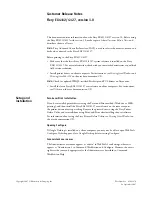
MPC Computers, LLC
NetFRAME 1420
Serial ATA (SATA)
Serial ATA (SATA) is a physical storage interface that uses a single cable with a minimum of four
wires to create a point-to-point connection between devices. It is a serial link, which supports
transfer rates up to 3Gbps. Because the serial cables used in SATA are thinner than the
traditional cables used in Parallel ATA (PATA), SATA systems have better airflow and can be
installed in smaller chassis than Parallel ATA. In addition, the cables used in PATA are limited to
a length of 40cm, while Serial ATA cables can be up to one meter in length. Overall, SATA
provides better functionality than PATA.
Introduction to Intel ICH7R Serial RAID
Located in the South Bridge of the E7230 Mukilteo chipset, the I/O Controller Hub (ICH7R)
provides the I/O subsystem with access to the rest of the system. It supports a 2-channel
UltraATA/100 Bus Master IDE controller (PATA) and four Serial ATA (SATA) ports. The ICH7R
supports the following PATA and SATA device configurations: Legacy mode and Native mode.
RAID Configurations
The following types of RAID configurations are supported:
RAID1 (Data Mirroring): an identical data image from one drive is copied to another drive. The
second drive must be the same size or larger than the first drive.
Intel Matrix Storage
The Intel Matrix Storage, supported by the ICH7R, allows the user to create RAID1 set by using
only two identical hard disk drives. The Intel Matrix Storage Technology creates two partitions on
each hard disk drive and generates a virtual RAID0 and RAID1 sets. It also allows you to change
the HDD partition size without any data.
Configuring BIOS settings for SATA RAID Functions (Native Mode)
1. Press the [Del] key during system bootup to enter the BIOS Setup Utility.
Note: If it is the
first time powering on the system, we recommend you load the Optimized Default
Settings. If you have already done so, please skip to Step 3.
2. Use the arrow keys to select the
Exit
Settings. Once in the
Exit
settings, Scroll down to
select
Load Optimized Default Settings
and press the [Enter] key. Select
OK
to confirm
the selection. Press the [Enter] key to load the default settings for the BIOS.
3. Use the arrow keys to select the
Main
section in BIOS.
4. Scroll down to
SATA Control Mode
and press the [Enter] key to select
Enhanced
.
5. Scroll down to
SATA RAID Enabled
and press [Enter]. Then, select
Enabled
.
6. Scroll down to
Exit
. Select
Save and Exit
from the
Exit
menu. Press the [Enter] key to
save the changes and exit the BIOS.
7. Once you've exited the BIOS Utility, the system will re-boot.
8. During the system boot-up, press the [Ctrl] and [I] keys simultaneously to run the Intel
RAID Configuration Utility when prompted by the following message: "Press <Ctrl> <I>
for Intel RAID Configuration Utility."
Содержание NetFRAME 1420
Страница 1: ...1 ...
Страница 29: ...MPC Computers LLC NetFRAME 1420 Slide System into Rack ...
Страница 92: ......
















































